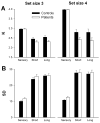Reduced capacity but spared precision and maintenance of working memory representations in schizophrenia
- PMID: 20530006
- PMCID: PMC2883794
- DOI: 10.1001/archgenpsychiatry.2010.65
Reduced capacity but spared precision and maintenance of working memory representations in schizophrenia
Abstract
Context: Working memory deficits are considered a core feature of schizophrenia. Several recent integrative articles have offered mechanistic computational and neurobiological models of the origins of this cognitive deficit.
Objective: To test predictions of these models using a new experimental paradigm from the basic science literature that makes it possible to determine whether patients with schizophrenia show (1) deficits in working memory storage capacity, (2) deficits in the precision of working memory representations, and (3) an amplification of these deficits as the retention interval increases.
Design: Case-control design. All subjects performed a color working memory test in which they were asked to recall 3 or 4 items after a 1- or 4-second delay. All subjects also received a standard measure of intelligence and the Matrics Consensus Cognitive Battery.
Setting: A tertiary care research outpatient clinic. Patients A total of 31 clinically stable patients with a DSM-IV diagnosis of schizophrenia or schizoaffective disorder and 26 healthy volunteers participated. The 2 groups were similar in age, sex, and ethnicity distribution.
Main outcome measures: (1) The number of items stored in working memory and (2) the precision of the working memory representations.
Results: Patients showed a clear reduction in the number of items stored in working memory. Patients did not differ from controls in the precision of their working memory representations. There was no evidence of delay-related amplification of impairment in either capacity or precision.
Conclusions: Patients do not show the type of imprecision or delay-dependent amplification of impairment that is predicted on the basis of current models of the neurobiology of schizophrenia. The models need to be revised to account for a pure reduction in the number of items that patients are able to store in working memory.
Conflict of interest statement
Conflicts of Interest Notifications: None of the authors have any conflicts of interest or financial disclosures that are relevant to the work presented here.
Figures




Similar articles
-
Dissociation of long-term verbal memory and fronto-executive impairment in first-episode psychosis.Psychol Med. 2009 Nov;39(11):1799-808. doi: 10.1017/S0033291709005935. Epub 2009 May 7. Psychol Med. 2009. PMID: 19419594 Free PMC article.
-
[Interest of a new instrument to assess cognition in schizophrenia: The Brief Assessment of Cognition in Schizophrenia (BACS)].Encephale. 2008 Dec;34(6):557-62. doi: 10.1016/j.encep.2007.12.005. Epub 2008 Jul 9. Encephale. 2008. PMID: 19081451 French.
-
Do sex differences affect prefrontal cortex associated cognition in schizophrenia?Schizophr Res. 2009 Feb;107(2-3):255-61. doi: 10.1016/j.schres.2008.09.021. Epub 2008 Nov 11. Schizophr Res. 2009. PMID: 19004617
-
The cognitive neuroscience of working memory: relevance to CNTRICS and schizophrenia.Biol Psychiatry. 2008 Jul 1;64(1):11-7. doi: 10.1016/j.biopsych.2008.03.003. Epub 2008 Apr 8. Biol Psychiatry. 2008. PMID: 18400207 Free PMC article.
-
The cognitive neuroscience of memory function and dysfunction in schizophrenia.Biol Psychiatry. 2008 Jul 1;64(1):18-25. doi: 10.1016/j.biopsych.2008.04.011. Epub 2008 May 21. Biol Psychiatry. 2008. PMID: 18495087 Free PMC article.
Cited by
-
Transdiagnostic comparison of visual working memory capacity in bipolar disorder and schizophrenia.Int J Bipolar Disord. 2021 Apr 2;9(1):12. doi: 10.1186/s40345-020-00217-x. Int J Bipolar Disord. 2021. PMID: 33797645 Free PMC article.
-
Cognition in schizophrenia: core psychological and neural mechanisms.Trends Cogn Sci. 2012 Jan;16(1):27-34. doi: 10.1016/j.tics.2011.11.015. Epub 2011 Dec 12. Trends Cogn Sci. 2012. PMID: 22169777 Free PMC article. Review.
-
GluN2B-containing NMDA receptors and AMPA receptors in medial prefrontal cortex are necessary for odor span in rats.Front Behav Neurosci. 2013 Dec 2;7:183. doi: 10.3389/fnbeh.2013.00183. eCollection 2013. Front Behav Neurosci. 2013. PMID: 24348356 Free PMC article.
-
Early sensory contributions to contextual encoding deficits in schizophrenia.Arch Gen Psychiatry. 2011 Jul;68(7):654-64. doi: 10.1001/archgenpsychiatry.2011.17. Epub 2011 Mar 7. Arch Gen Psychiatry. 2011. PMID: 21383251 Free PMC article.
-
Nicotine improves working memory span capacity in rats following sub-chronic ketamine exposure.Neuropsychopharmacology. 2011 Dec;36(13):2774-81. doi: 10.1038/npp.2011.224. Epub 2011 Sep 28. Neuropsychopharmacology. 2011. PMID: 21956441 Free PMC article.
References
-
- Barch DM. The cognitive neuroscience of schizophrenia. Annual Reviews of Clinical Psychology. 2005;1:321–353. - PubMed
-
- Lee J, Park S. Working memory impairments in schizophrenia: A meta-analysis. Journal of Abnormal Psychology. 2005;114:599–611. - PubMed
-
- Manoach DS. Prefrontal cortex dysfunction during working memory performance in schizophrenia: Reconciling discrepant findings. Schizophrenia Research. 2003;60:285–298. - PubMed
-
- Callicott JH, Mattay VS, Verchinski BA, Marenco S, Egan MF, Weinberger DR. Complexity of prefrontal cortical dysfunction in schizophrenia: More than up or down. American Journal of Psychiatry. 2003;160:2209–2215. - PubMed
-
- Baddeley AD. Working Memory. Clarendon; Oxford: 1986.

